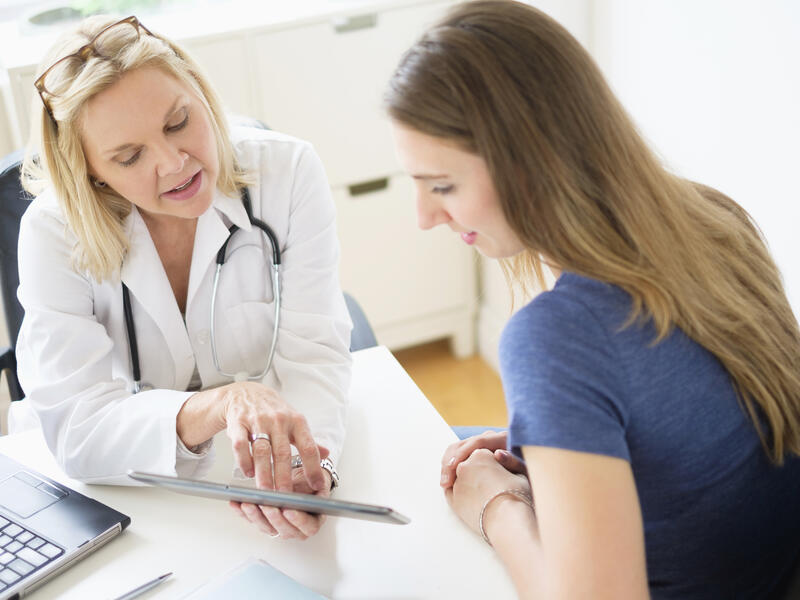Endometriosis does not have a cure but it does have effective treatments, a Sanford Health expert says.
Too often people don’t seek care for their symptoms. The result is that proper diagnosis and treatment can be delayed by a decade or more, the Endometriosis Foundation of America estimates.
We recently asked Cynthia Davis, M.D., a women’s health specialist at Sanford Chamberlain Clinic in South Dakota, to explain what endometriosis is and how it is treated.
What is endometriosis?
Endometriosis is a condition where endometrial tissue (the part of the uterus that causes menstrual bleeding each month) is found outside the uterus.
Each month, this misplaced tissue responds to the hormonal changes of the menstrual cycle. It builds up, breaks down, and bleeds. The blood has nowhere to go, however, which causes surrounding tissue to become inflamed or swollen. It can also cause scar tissue, chronic pain, and heavy periods.

Endometriosis is a common cause of infertility in women. It can implant in the tubes, ovary, pelvis and sometimes outside the pelvis.
We have several theories about what causes this, but none have been proven. About 10% of reproductive-age females will have endometriosis but it is present in as many as 50% of women with infertility and 70% of women with chronic period pain, including teens.
Endometriosis is different than endometritis. Endometritis is a chronic inflammation in the inner lining of the uterus (the endometrium). It can be caused by STDs or other infections. Sometimes endometritis is chronic and unclear in cause.
What are the symptoms?
Endometriosis can have several different kinds of symptoms. For some women, the first symptom is difficulty with getting pregnant, but typically, chronic pelvic pain (usually during the week before and first few days of a menstrual cycle) indicates endometriosis.
However, chronic pain or pressure, or pain during sex or bowel movements could also be a symptom.
If endometriosis is present on the bowel it can be associated with constipation or blood in the stool. If present on the bladder, it can lead to issues with frequency, urgency, bladder pressure, and blood in the urine.
How is endometriosis diagnosed?
Endometriosis is diagnosed by a procedure called a diagnostic laparoscopy. This is where the gynecologist does a minor surgery where a camera is placed through the umbilicus (navel or belly button), and endometriosis is directly observed after careful inspection.
Ideally, these spots are removed during the procedure to confirm the diagnosis. This is usually a same-day surgery and is generally the best treatment for women with infertility caused by endometriosis.
What are treatment options for endometriosis?
There are several simple treatment recommendations that we usually start with unless the patient has contraindications. Very often birth control pills are effective to suppress endometriosis, although this can take several months.
Often we combine this kind of “suppressive” therapy with additional ways to treat pain. These include nonsteroidal anti-inflammatory drugs like ibuprofen, as well as Tylenol, and medicines that target nerve fibers that can become overstimulated and sensitized.
As mentioned above, surgery can help with treating endometriosis. However, this tends to be a chronic disease and we usually recommend some kind of suppressive therapy long term, like the birth control pill, even after surgical treatment.
What will happen if I do nothing?
Unfortunately, endometriosis — including pain and risk for infertility — will often worsen over time if left untreated. It is recommended that early interventions, such as birth control pills, be considered given the potential consequences.
Hormonal treatments, even in young women, are very low risk. Typically, endometriosis improves with pregnancy and menopause but this is not always the case.
If I think I might have endometriosis symptoms, what information will I want to tell my doctor?
If you think you might have endometriosis, it will be helpful for your doctor to know several things:
- The nature of your pain. Sharp, dull, timing with period, other symptoms like bowel or bladder, or pain with intercourse.
- When you first started noticing the symptoms and how they have progressed.
- Whether you’ve had any studies done, like an ultrasound. If so, please have them sent to your doctor.
- What you have tried for your pain. What side effects you did you have? How well did they work? If you have tried hormonal suppression, you will want to keep track of how long you tried it.
- If you’re having trouble getting pregnant, how long have you been actively trying? Having had a previous child does not necessarily mean that you do not have endometriosis now.
If you are experiencing symptoms or want to learn more about endometriosis, talk with your provider.
Learn more
- Infrequent or absent periods may be potentially serious PCOS
- The impact of uterine fibroids on women’s health
- Effective ways to ease periods for women and teens
…
Posted In Healthy Living, Women's
